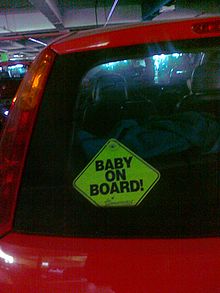"Baby on board" is the message of a small (usually 12 centimetres or 5 inches) sign intended to be placed in the back window of an automobile to caution other drivers that an infant is travelling in the automobile.

The sign may also be intended as a warning to emergency personnel in case of emergency, as there may be a baby in the vehicle. However, this is not the intended purpose as stated by the company Safety 1st, which was marketing the product at the time of its peak popularity.
History and popular use
A version of the sign was found in Germany by Patricia Bradley of Medford, Massachusetts. With her sister Helen she started a company, PHOB, to market them in the US, but had only limited success until partnering with Michael Lerner.
Lerner was told about the signs after recounting his experience of aggressive drivers when driving his baby nephew home in busy traffic. An urban legend claims that the death of a baby led to the creation of the signs, but there is no truth to this claim. Lerner eventually bought PHOB for approximately US$150,000, and changed the name to "Safety 1st". The company later diversified into infant and child care products and is now part of Dorel Industries.
The sign became a ubiquitous fad, flourishing in 1985. Its use in the US rapidly declined in 1986 as parody imitations with lines like "Baby I'm Bored", "Pit Bull on board", and "Mother-In-Law in Trunk" became popular, although its popularity continues in the United Kingdom (along with other versions such as "Princess on board" and "Little Person on board"), in Italy and in Japan (usually saying "Baby in Car", with the sign written in either English or Japanese script) well into the 21st century.
Despite waning in popularity, the signs have entered the American lexicon. In 1993, The Simpsons episode "Homer's Barbershop Quartet" featured a barbershop quartet tune called "Baby on Board". The song was written by Homer Simpson in a flashback to 1985 when Marge bought a sign, hoping it would stop people from "intentionally ramming our car".
Following popular request and trials in 2005, Transport for London (TfL) began issuing badges with the TfL logo and the words "Baby on board!" to pregnant women travelling on the London Underground, to help other passengers identify pregnant travellers who would like to be offered a seat.
References
- ^ Merelli, Annalisa (6 October 2014). "You Probably Don't Know The Real Story Behind Baby On Board Signs". Quartz (publication). Retrieved 8 December 2016.
- ^ May, Jeff (13 June 2011). "After the One-Hit Wonder". The Wall Street Journal. Archived from the original on 3 May 2016. Retrieved 6 October 2014.
- ^ "Baby on Board". Urban Legends Reference Pages. 2 September 2006. Retrieved 6 February 2007.
- "Fun Galleries | FacThat". Archived from the original on 12 January 2015. Retrieved 12 January 2015.
- "Tube trials 'Baby on board' badges for mums-to-be". Transport for London. 7 March 2005. Archived from the original on 25 April 2012. Retrieved 21 April 2012.
- "Baby on Board". Transport for London. 2 April 2012. Archived from the original on 17 July 2012. Retrieved 21 April 2012.
Further reading
- Gibson, Caitlin (1 May 2019). "'Baby on Board': How a cutesy decal embodies the enduring terror of parenthood". The Washington Post. Retrieved 27 February 2023.